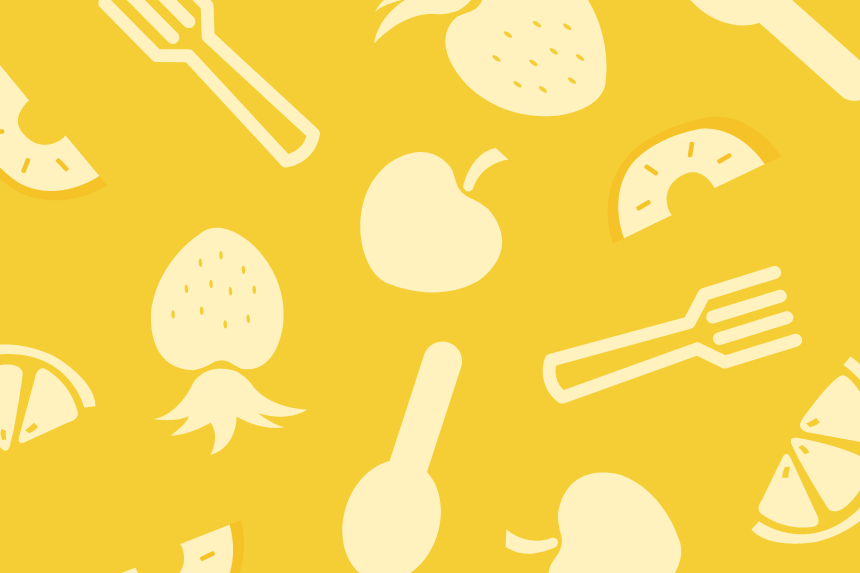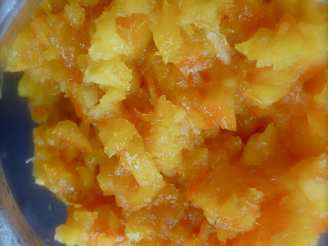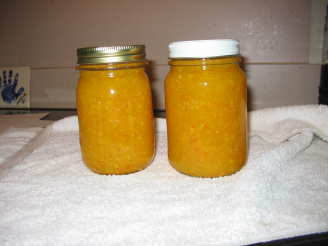Orange Marmalade

- Ready In:
- 4hrs 30mins
- Ingredients:
- 11
- Yields:
-
14-15 half pints
- Serves:
- 240
ingredients
- 6 -7 large juicy navel oranges
- 3 -4 large juicy lemons
- 1 cup granulated sugar, plus
- 4 lbs granulated sugar, plus
- more granulated sugar, divided,to taste
- 1 cup water, plus
- 5 cups water, divided
- 1 cup dry white wine
- 2 -3 tablespoons fresh lemon juice
- 1 -3 teaspoon citric acid (citric acid granules) or 1 -3 lime, juice of (optional)
- 1 box ball fruit jell pectin or 1 box other no-sugar needed pectin
directions
- Equipment you will need: 1 Large plastic bowl with lid; 1 Large nonreactive Dutch oven; 1 Water-bath processor or very large stock pot with a rack to keep jars off bottom of pot; 1 Pair jar-lifting tongs (optional, but very handy); 1 Magnetic lid lifter (optional, but very handy); 14-15 Half-pint or 7 1-pint canning jars with threaded rings and new lids.
- Cut the zest (the thin orange portion of the peel) from all of the oranges using a vegetable peeler or sharp paring knife (about 1/16" thick or less and about 3/4" wide).
- Cut the zest into thin strips about 1/16" wide, and set aside.
- Using a micro-plane or regular grater, grate the zest from the lemons, and add to the orange zest.
- Peel the oranges and lemons with a sharp knife, removing most of the thin outer membrane from the fruit, as well as the white portion of the peel.
- Cut the flesh of the lemons and oranges into 1/4" thick slices, remove seeds as necessary, chop into 1/4" pieces, saving as much juice as possible, and place in a large plastic bowl.
- If desired, mash the fruit just a little bit using a potato masher, but you want it to stay fairly chunky.
- In a medium saucepan, combine the 1 cup water, white wine, lemon juice, and sugar over medium heat, and stir until sugar is dissolved.
- Add the orange and lemon zest, and stir to combine.
- Bring to a boil, reduce heat to a good simmer, and cook until zest strips are fairly tender.
- Remove from heat, and set aside to cool.
- Add zest mixture and 5 cups of water to fruit, stir to combine, cover tightly, and refrigerate or set in a cool place for 24 hours or a little longer.
- This aging is mandatory for flavor development.
- Before starting to actually make the marmalade, assemble all necessary equipment.
- Fill a water bath or very large stock pot with enough hot water to cover jars by at least 1-2".
- Jars can be stacked, if necessary, while processing.
- It will probably take longer to heat the water than to prepare the marmalade, so give it a good head start.
- Sterilize canning jars by running them through a full hot-cycle of the dishwasher, or wash in hot, soapy water, rinse well, and drain.
- In either case, transfer the jars to a 250 degee F oven until ready to fill them.
- Place new canning lids in a small saucepan of boiling water until needed.
- You should have between 9 and 10 pounds (18-20 pints) of fruit and zest mixture at this point, but this will reduce down to 7+ pounds (14-15 pints) during cooking.
- Transfer fruit and zest mixture to a large, nonreactive Dutch oven over high heat, and bring to a full boil, stirring and scraping the bottom of the pan regularly to prevent scorching.
- Taste, and adjust tartness to taste using sour salt or lime juice (sour salt, 1 Tsp at a time, is easiest), and adjust sweetness to taste with additional sugar.
- Continue to boil, stirring and scraping bottom regularly to prevent scorching, until mixture reaches a temperature of 220 degrees F on a instant-reading or candy thermometer (actually, 8 degrees F above the boiling point of water at your elevation).
- Stir in the'no-sugar required pectin', and continue to boil for 1 minute longer, remove from heat, and allow to set for 2-3 minutes; setting helps solids to stay in suspension instead of sinking to the bottom of the jars.
- Stir marmalade well, and ladle into sterilized canning jars to within 1/8" of the rim.
- Clean the rim and threads of each jar with a dampened paper towel, top with sterilized new lids, screw on threaded rings, and tighten hand-tight.
- Immediately transfer to a water bath with enough boiling water to cover jars by at least 1-2".
- Process for 10 minutes, starting timing when water returns to a boil.
- Remove jars from water bath, invert onto a kitchen towel, and allow to set without disturbing until cooled completely.
- Turn jars over, and press down on each lid.
- If it does not pop up and down with pressure, the jar is sealed and can be stored in a cool, dark place for up to a year.
- Jars with lids that do pop up and down have not sealed properly and should be refrigerated and used first.
- Makes about 14-15 half-pint or 7 1-pint jars, with a little extra for the fridge.
Questions & Replies
Got a question?
Share it with the community!
Reviews
-
Very clear instructions step by step. A vegetable peeler is the best way to go on peeling oranges and lemons - you want a little white backing as it gives marmalade that bitter taste that is so revered. Step 23 is the most sophisticated element of this recipe. Too many folks make jams or spreads with no knowledge on how to adjust the flavors. I taste my jams for sweetness and also for flatness and that "sweet/sour bite". This is a rare recipe that tells you how to adjust that element if you will take just a minute to prepare yourself in the event it is needed. I found that I liked the recipe without added lime juice or citric acid but the lime and citric acid were sitting next to the cook pot in the event it was needed. I did save my pips, segments, and a few peels and boiled them up the night before and squeezed out the pectin and added in place of some of the water to help guarantee a set (may take days to set up so do not get too impatient). I also added 1/4 tsp of fresh ground nutmeg and 1/3 of a fresh vanilla bean (inside scraped and exterior pod removed before jarring marmalade). Step 18 is an unnecessary step as the spread is processed for 10 minutes. Step 20 is incorrect in that Jardin Foods has reformulated the sealant on canning lids from rubber to a silicone. Jardin recommends that you DO NOT boil lids of current manufacture and that you just soak them in hot water (not boiling) for 5 minutes before placing lids on jars. Steps 30, 31, and 32 are no longer recommended and may result in seal failure. You may gently rotate jars (do not shake) to distribute solids. Step 33 has another option. Just remove unsealed lid, wipe jar top, and install new lid and reprocess for another 10 minutes. If needed, you must do this within 24 hours. I however, do this as soon as I find a jar has not sealed. I do NOT want to reheat the jam in a saucepan, rejar, and recap. So I do it immediately while the jar contents are still warm. Hope this help a reader someday. Making marmalade is really great because it cost very little to make it, it is used in many other recipes, and it tastes great on toast, biscuits, bbq chicken, and on and on. Enjoy! Jim in So Calif
RECIPE SUBMITTED BY
Toby Jermain
Houston, TX
I WAS retired oilfield trash since 1999, who has lived in Houston TX for the last 25 years, though I'm originally from California. I'm Texan by choice, not by chance! I am now working in Algeria 6 months a year, so I guess that gives new meaning to the term SEMI-retired. I grew up in restaurants and worked in them for 13 years while getting through high school and college, working as everything from dishwasher to chef, including just about everything in between. At odd intervals I also waited tables and tended bar, which gave me lots of incentive to stay in school and get my engineering degree.
During the 33 years since, I have only cooked for pleasure, and it HAS given me a great deal of pleasure. It's been my passion. I love to cook, actually more than I love to eat. I read cookbooks like most people read novels.
My wife and I both enjoy cooking, though she isn't quite as adventurous as I am. I keep pushing her in that direction, and she's slowly getting there.
We rarely go out to eat, because there are very few restaurants that can serve food as good as we can make at home. When we do go out, it's normally because we are having an emergency junk-food attack.
My pet food peeves are (I won't get into other areas): are people who post recipes that they have obviously NEVER fixed; obvious because the recipe can't be made because of bad instructions, or that are obvious because it tastes horrible. I also detest people who don't indicate that a recipe is untried, even when it is a good recipe. Caveat emptor!




